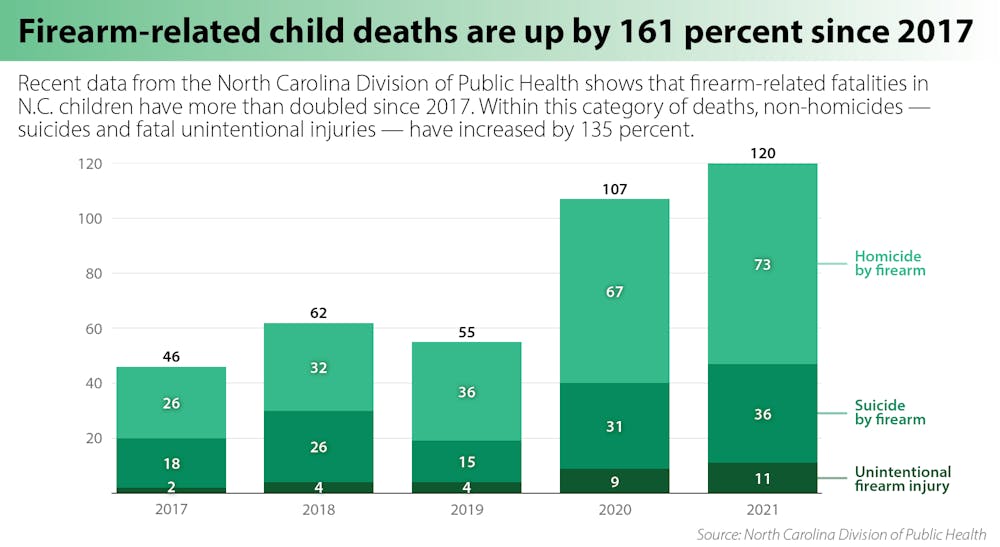The report said there were notable increases in homicides, suicides and motor vehicle injuries among children.
Firearm death rates have increased by 231.3 percent from 2012 to 2021, and firearms were used in over 70 percent of suicides and homicides in 2021.
According to a 2021 survey, 30 percent of high school students in North Carolina reported that it would take them less than an hour to obtain and prepare to fire a loaded gun without permission from an adult.
Kella Hatcher, the executive director of the Child Fatality Task Force, said preventing gun deaths is a priority for the task force. The program has been trying to launch a statewide firearm safe storage awareness initiative, she said.
More than two-fifths of adults in North Carolina have a firearm in or around their home, according to a 2021 survey. Over half of the firearms stored loaded are also left unlocked.
The report said those deciding to attempt suicide often do so during short-term crises and that access to firearms significantly increases the chance of fatality.
Hatcher said another recommendation for suicide prevention is to increase the amount of nurses, counselors and social workers in schools. The national recommended ratio for social workers to students is one to 250. The ratio in North Carolina is one to 1,025.
“We have heard a lot in our task force meetings about the importance of these professionals and the way in which they’re able to identify kids who may be at risk,” Hatcher said. “They may be able to help them get connected to services in their communities or help them avert a crisis.”
Infant deaths
The infant mortality rate for 2021, which was 6.8 per 1,000 live births, remains the lowest rate that North Carolina has recorded, but the state still ranks among one of the highest infant mortality rates in the nation.
Sarah Verbiest, co-chairperson of the Perinatal Health Committee and a professor in the UNC School of Social Work, said safe sleep is one of the leading ways to prevent infant deaths. She said education regarding safe sleep is complicated and nuanced.
Verbiest said there are significant disparities in maternal health, as well as infant health, and death. According to the report, Black infants are more than twice as likely to die than white infants.
To get the day's news and headlines in your inbox each morning, sign up for our email newsletters.
She said disparities, including access to care and the quality of treatments, exist across the perinatal system.
“We really think about all of the strategies that we put forward with that equity lens to make sure that it’s going to focus on closing those gaps,” Verbiest said.
Child fatality data reporting
Hatcher said North Carolina lacks a centralized system of reporting and data collection for child death review teams at a state level. She said joining 48 other states in using a national data system would significantly improve child death prevention measures.
A data system would allow the state to look at information in a more applied way, and providing resources for workers would allow them to better do their work, Verbiest said.
Martha Sue Hall, co-chairperson of the Unintentional Death Prevention Committee and mayor pro tem of Albemarle, said child fatality teams in all 100 counties have continued to do their job but worry about the impact of their work.
“What we’re hoping to do is to revamp the system, so that what’s done locally in the furthest county in the east or the furthest county in the west has an impact on what’s going on statewide,” Hall said.
@madelynvanmeter
@DTHCityState | city@dailytarheel.com



